The New Jews of Show Low, Arizona: How a pastor parted with Jesus and led his congregation to Judaism
Twenty-one men, women and children from Richard Cortes’ formerly Messianic congregation became Jews on one day last month
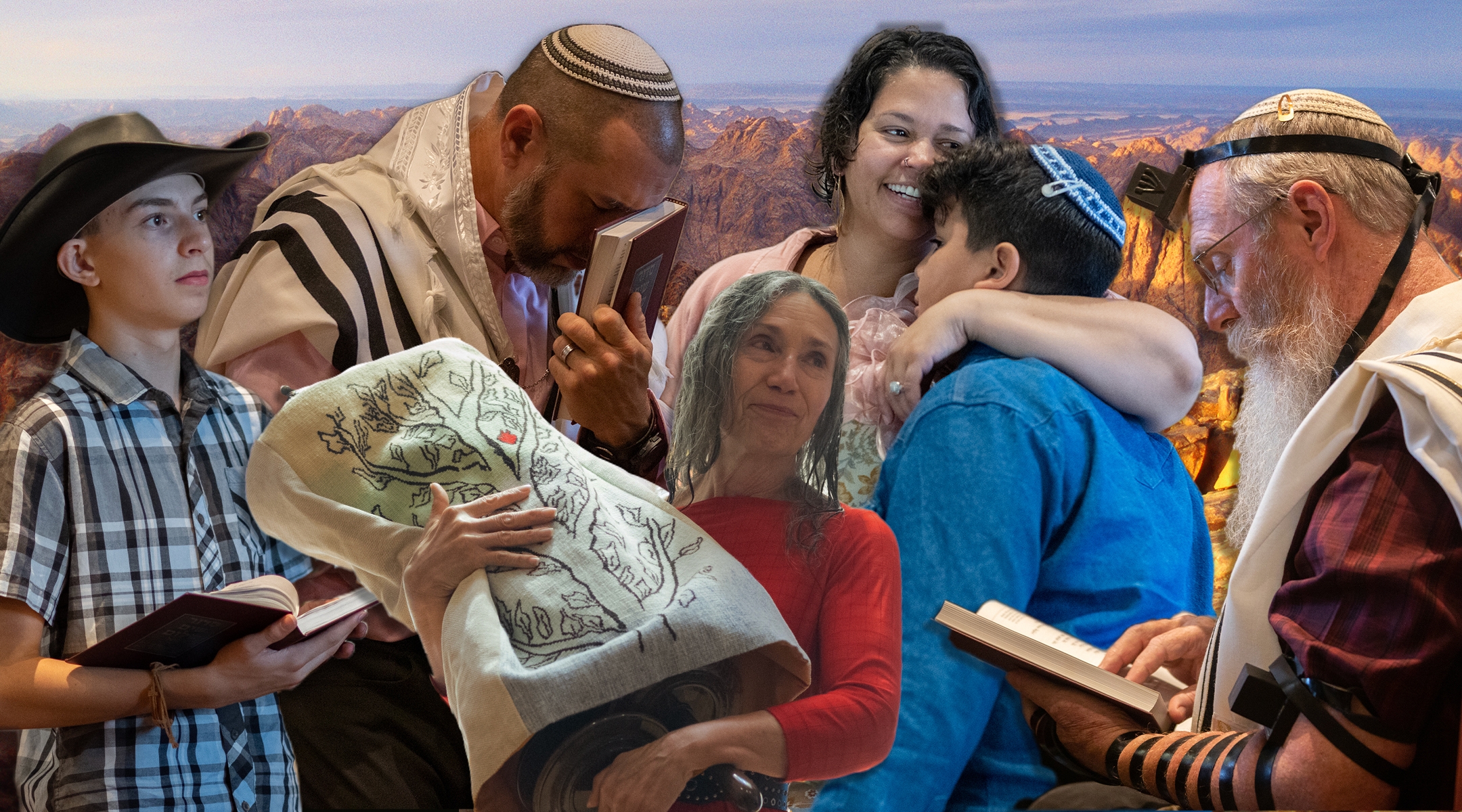
Photographs of converts by Caitlin O’Hara, collage design by Mollie Suss.
(JTA) – Richard Cortes can trace his spiritual development to a class field trip at a Florida theme park.
It was 2008 and Cortes was taking classes at a Pentecostal megachurch, on a path toward seminary and eventually leading a congregation, when his group spent the day at Orlando’s Holy Land Experience.
The creation of the park, which has since shuttered, had worried Jewish groups. They were concerned it might be intended as a tool of proselytization because its founder, Marvin Rosenthal, was a Jew who became a pastor, referred to himself as a “Christian Hebrew” and engaged in missionary work.
For Cortes, the park had the opposite effect. He marveled at the imaginative recreations of the biblical world he had been studying, explored the Second Temple-era replica of Jerusalem, and strolled through a scriptorium that displayed Torah scrolls. But when he encountered a park employee playing the character of Aaron, the biblical priest and brother of Moses, and heard the blast of the shofar Aaron carried, something broke open deep inside Cortes. He realized he wanted to experience religion the way Aaron did.
Cortes couldn’t sleep that night, staying up in a fervor of weeping and prayer. His soul had been stirred by the encounter, and the feeling was so intense he would later liken it to being reunited with a long-lost parent. He was also a little embarrassed. Traditional Christianity was now so clearly in his eyes a false religion that he kicked himself for not having realized it sooner.
When the sun came up, he woke up his wife, Alpha, and told her he could no longer return to the church. He was determined to find a synagogue, he told her. A Christian herself, Alpha resisted for months as her husband charted a path toward what is known as Messianic Judaism, a religion rejected by all mainstream Jewish groups that combines the practice of Jewish rituals with the worship of Jesus as the messiah.
But she ultimately came along, and over time, so did more and more people. By last year, Cortes was leading a thriving Messianic community in a remote mountain town in Arizona. Drawing from the area’s heavily Mormon and evangelical population, Cortes’ congregation was seen as a successful outpost in the wider Messianic movement.
Yet an uneasy feeling was gnawing at Cortes. Messianism promised that he would find proof of Jesus’ divinity within Jewish texts, but the harder he looked, the less he could see, leaving him in spiritual crisis. He was confused about how to proceed and terrified about the reaction of his wife and congregants to his internal transformation, but he knew he had to make a change.
Last month, Cortes and 20 of his followers converted to Judaism. Dozens of others in his community are considering doing the same.
Their mass conversion is an event with few precedents in Jewish history and a seemingly unlikely outcome for a group of people who live hours away from any Jewish community. The presence in Phoenix of a rabbi with an open mind and unusual point of view and the shifting of Jewish life online because of the pandemic opened doors that might otherwise have been closed. But it was not only Cortes and his followers undergoing a transformation: The very idea of who is a Jew, and how one becomes Jewish, is changing, too.
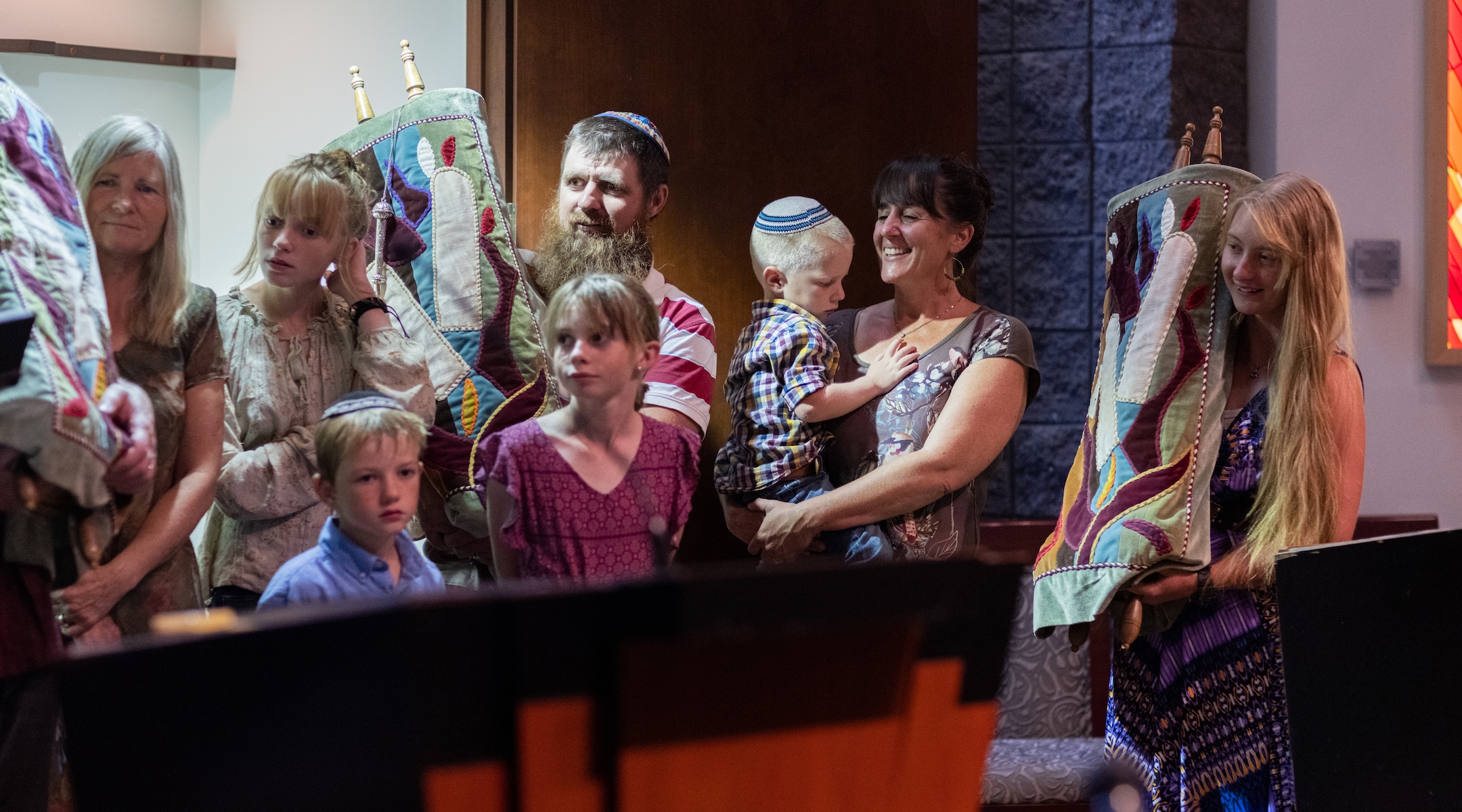
Jubal Most, 3, inspects his mother Stefani Most’s new Star of David necklace while his family is prayed over at Congregation Beth Israel in Paradise Valley, Arizona, Aug. 17, 2023. (Caitlin O’Hara)
On the day of their conversion at a synagogue in a suburb of Phoenix last month, Cortes, 53, said he regretted his prior association with the Messianic movement, accusing it not only of inappropriately adopting symbols of Jewish religious observance like the kippah and the shofar but also of masking its tenets in order to proselytize to Jews.
“I never partook in missionary activity but the fact is that I was involved in a movement that did a lot of missionary work,” he said. “I am just completely appalled that I was a part of it.”
Cortes was wearing a dress shirt and slacks and sported a close-cropped beard. His eyes were shielded by athletic sunglasses as he lingered in the synagogue’s sweltering courtyard, awaiting his turn to appear before a Jewish court, immerse in a mikvah or ritual bath, and receive a Hebrew name.
In converting, he hoped to demonstrate the sincerity of his transformation, mark a clean break with past worship and usher in a new and final phase in his dramatic spiritual journey.
“This day is about righting a wrong and holding our hands with our new brothers and sisters,” Cortes said. “We are so excited to be a part of the Jewish community, and to prove ourselves to the Jewish community that we are legitimate.”
The next day, Cortes would attend his first Shabbat dinner as a Jew; the day after that, he’d be called up to the Torah for the first time, at Congregation Or Tzion in Scottsdale, the Conservative synagogue whose rabbi, Andy Green, had convened his conversion court. And then on Sunday Cortes and the other new Jews of Show Low, Arizona, would head home to their mountain town in a remote corner of the state to begin the rest of their lives as a Jewish community.

No Jewish denomination regards the Messianic movement or belief in Jesus as compatible with Judaism. Nevertheless, about 225,000 American adults identify as Messianic Jews, according to data from a 2020 Pew Research Center study. (An additional, unknown number of people belong to the Hebrew Roots movement, a related denomination that also blends Jewish practice with Christian belief but differs on some doctrinal issues.)
Experts say the Messianic movement is growing rapidly in many places in the world, competing, for example, with the evangelical church for lapsed Catholics in Latin America and the Philippines. As it grows, however, the movement is also hemorrhaging adherents who come to experience it as a stepping stone on the way to something else.
Some turn to Noahidism, a pared-down version of Judaism that doesn’t require conversion. A concept that comes from the book of Genesis and is developed through rabbinic discourse in the Talmud about halacha, or Jewish law, Noahidism stems from the story of Noah and teaches that there are seven basic commandments applying to all people, Jewish or not. A contemporary religion based on the seven Noahide commandments is growing rapidly, says Rachel Z. Feldman, a professor of religion at Dartmouth College and the author of a forthcoming book offering the first comprehensive academic look at the phenomenon.
“A theological and abstract concept that we’ve been talking about in the halacha for thousands of years is now for the first time in history being transformed into a living faith identity,” said Feldman, who does ethnographic research on Noahide communities and estimates the number of followers in the tens of thousands worldwide.
Feldman said the Show Low group fits within the global trend she’s been examining.
“We’re talking about a massive new movement of the Jewish world that not that many people know about. Entire congregations, like the one in Arizona, are leaving Christianity,” she said.
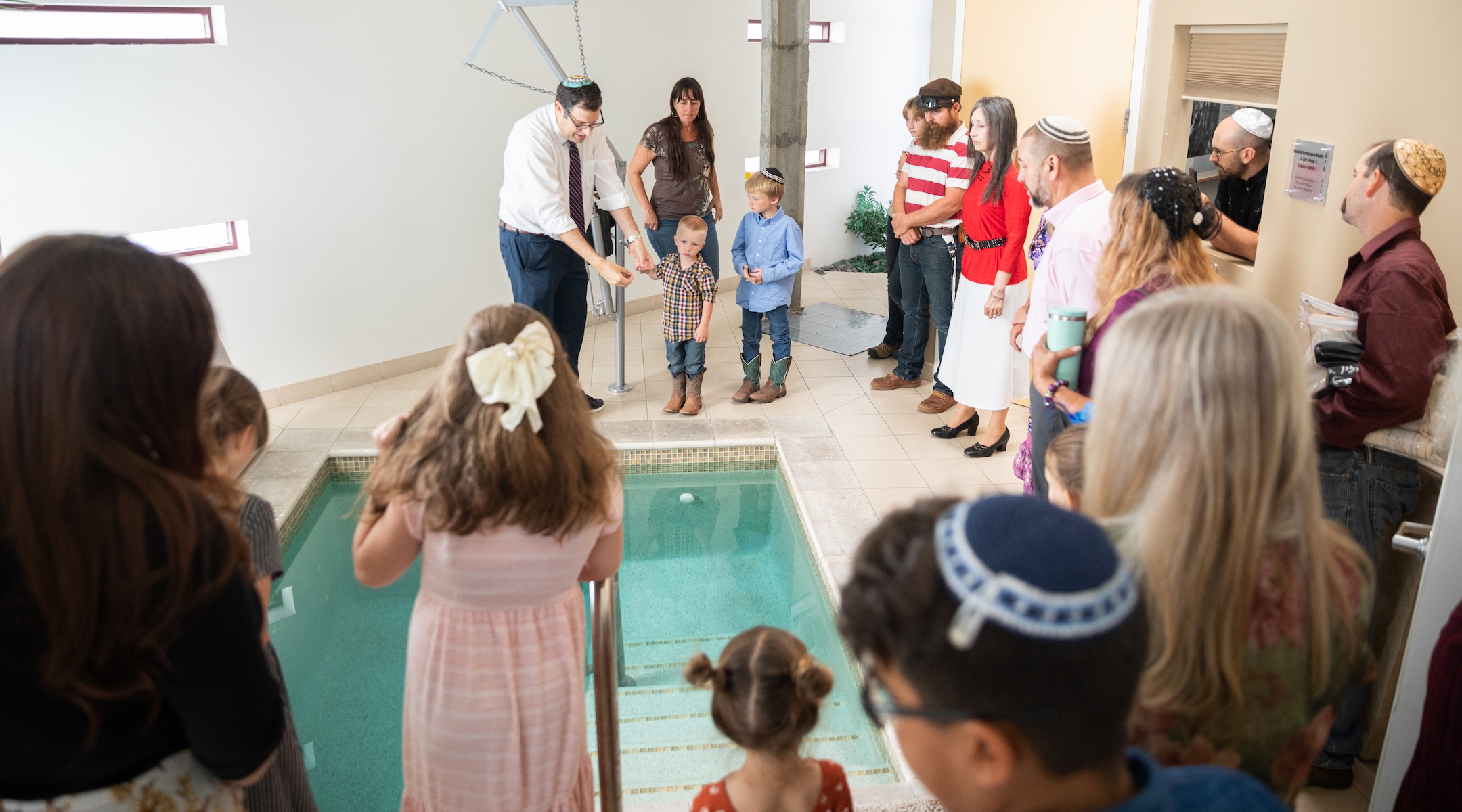
Or Tzion rabbi Andy Green holds the hand of Jubal Most, 3, and he and his family and fellow congregants look on as the rabbi explains the Mikveh ritual bath in Paradise Valley, Arizona, Aug. 17, 2023. (Caitlin O’Hara)
Others who leave the Messianic movement ultimately hope to reach Judaism. But Judaism is not an easy religion to join. Prospective converts must form relationships with rabbis and convince them of their sincerity, which can be difficult in the many places where there are no rabbis, no way to participate in Judaism’s communal practices, and not even any Jews to learn from.
To make matters more challenging, Messianics are deeply distrusted in the Jewish world. They are often seen as agents of a Christian effort to proselytize by masquerading as Jews — an effort that some Messianics embrace. Deceitful tactics by Messianic missionaries since the movement was founded several decades ago, especially the offshoot Jews for Jesus, echo a longer, painful history of forced conversions by the church. Many even consider the movement antisemitic for claiming that rabbinic scholars have intentionally suppressed the truth of Jesus.
But experts also say the Jewish community has become so accustomed to thinking of Messianics as a potential threat that it’s failing to perceive an important new phenomenon: Although covert Messianic missionaries do continue to exist, many more from the movement seem to be abandoning Jesus with a genuine hope to engage with Jews.
“It’s sort of ironic, right? This movement that was supposed to be so feared, you could say is the greatest producer of new converts, probably in the world today,” Taylor said.
“It is quite possible that there is no group today more responsible for conversion to Judaism than Jews for Jesus, than the Messianic movement,” said Tovia Singer, an Orthodox rabbi who heads Outreach Judaism, a counter-missionary organization that serves as one of the first ports of call for questioning and lapsed Messianics.
“Richard’s case seems like a very rare story, but there are many people like him,” said Pinchas Taylor, a rabbi trained by the Hasidic Chabad movement who heads American Faith Coalition, a group catering to spiritual seekers of all backgrounds. He said he’s encountered thousands of people who have left Christianity and become interested in learning Jewish wisdom, even if they are not always able or seeking to convert.

Cortes was born in New York City in 1971 and lived happily among Jews in Brooklyn and the Bronx until his family moved him to Puerto Rico when he was a young teen. He attended a Pentecostal church in his youth and became irreligious as an adult only to be drawn back in, leading him in his late thirties to take preparatory classes to join a seminary program at Victory Church in Lakeland, Florida. He left the church following his epiphany at the Holy Land Experience theme park and connected with a Messianic synagogue near his home in the Orlando area.
Richard immersed himself in Jewish texts, reading the weekly Torah portion and studying Jewish sages from Rashi to the Rambam. Hoping to delve deeper, he began to learn Hebrew. He eventually became ordained as a Messianic pastor. On a trip to Israel, he visited the Western Wall and, surrounded by Jewish worshippers, he prayed about bridging the gap between his Messianic community and the Jewish world. “I prayed, asking, ‘Why can’t the Jewish people just receive us?’ We love the Torah. We’re not the church,” Cortes recalled.
About a decade ago, Cortes and his wife Alpha left Florida and moved to Show Low in search of a fresh start and a flock with which to share their creed. The town is known for its unusual name and as a summer destination for people fleeing the Sonoran Desert heat. (Show Low is named, according to legend, after a fateful game of cards in the Old West, which ended when one rancher beat another by showing a deuce of clubs.)
As he ran errands in town, people noticed the tzitzit, fringes of a Jewish prayer shawl, hanging from his clothes and the conversations that followed brought in some of his first congregants. Cortes ministered to them out of a tent located on the rural 10-acre property he had bought.
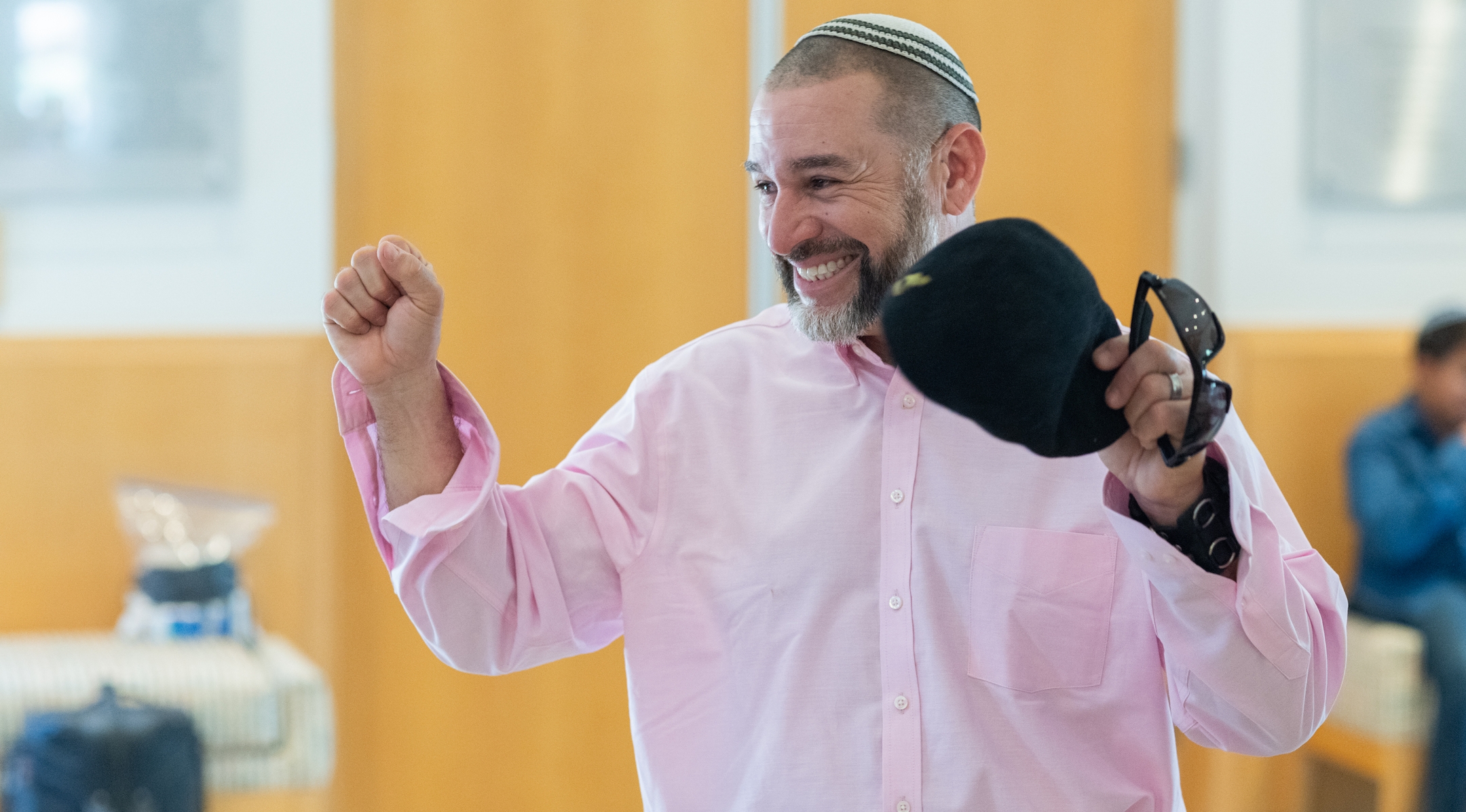
Richard Cortes cheers after his mikveh at Congregation Beth Israel in Paradise Valley, Arizona, Aug. 17, 2023. (Caitlin O’Hara)
The congregation, which he called Foundation of the Word Outreach Ministries, grew over time, eventually counting about 80 members, with more tuning in remotely. Followers came to witness Cortes teach, as the congregation’s website put it, the “Hebrew roots of the gospel” and help build a “Torah-based homestead community” devoted to the worship of Messiah Yeshua, the Messianic name for Jesus. Though they practiced Jewish customs and rituals and identified as Jews, no stream of Judaism regarded them as such.
Cortes’ congregation was a success story for the Messianic movement. He had come to a small town with no organized Messianic presence and well-established Mormon and evangelical churches and founded a thriving house of worship; usually, Messianic groups were organized as home fellowships and stayed that way if they didn’t fall apart quickly after forming. He was invited to join an online group of fellow Messianic leaders and regularly led workshops on his favorite topics for them.
Even as he preached, however, Cortes began to harbor doubts. “I was finding a lot of discrepancies,” he said. “So I decided to take my time and do an assessment.” He announced to his congregation that he would stop teaching the New Testament as he spent time studying it and focus in the meantime on lessons from Judaism.

The first time Cortes heard the name Tovia Singer, it was uttered in online conversations among leaders of the Messianic movement. They demonized the anti-missionary rabbi and warned that he was leading many of their followers astray. “I was already on the journey of saying goodbye to Yeshua, but of course, I didn’t reveal that yet,” Cortes said.
Singer’s name came up again a little while later. Cortes’ self-study was getting him only so far and he began seeking out a teacher or guide. He began following online content produced by Nissim Black, an African-American rapper and podcaster who has spoken extensively about being raised a Christian and turning to Messianism before converting to Orthodox Judaism. One day, Black’s YouTube talk show publicized a new episode featuring Singer as a guest.
For two days, Cortes couldn’t get himself to hit play. The voices cautioning against Singer kept bouncing around in his head. “I started talking to myself and asking, ‘Why am I so afraid?’” Cortes recalled. He finally decided to watch the video, “and that was the beginning of the end.”
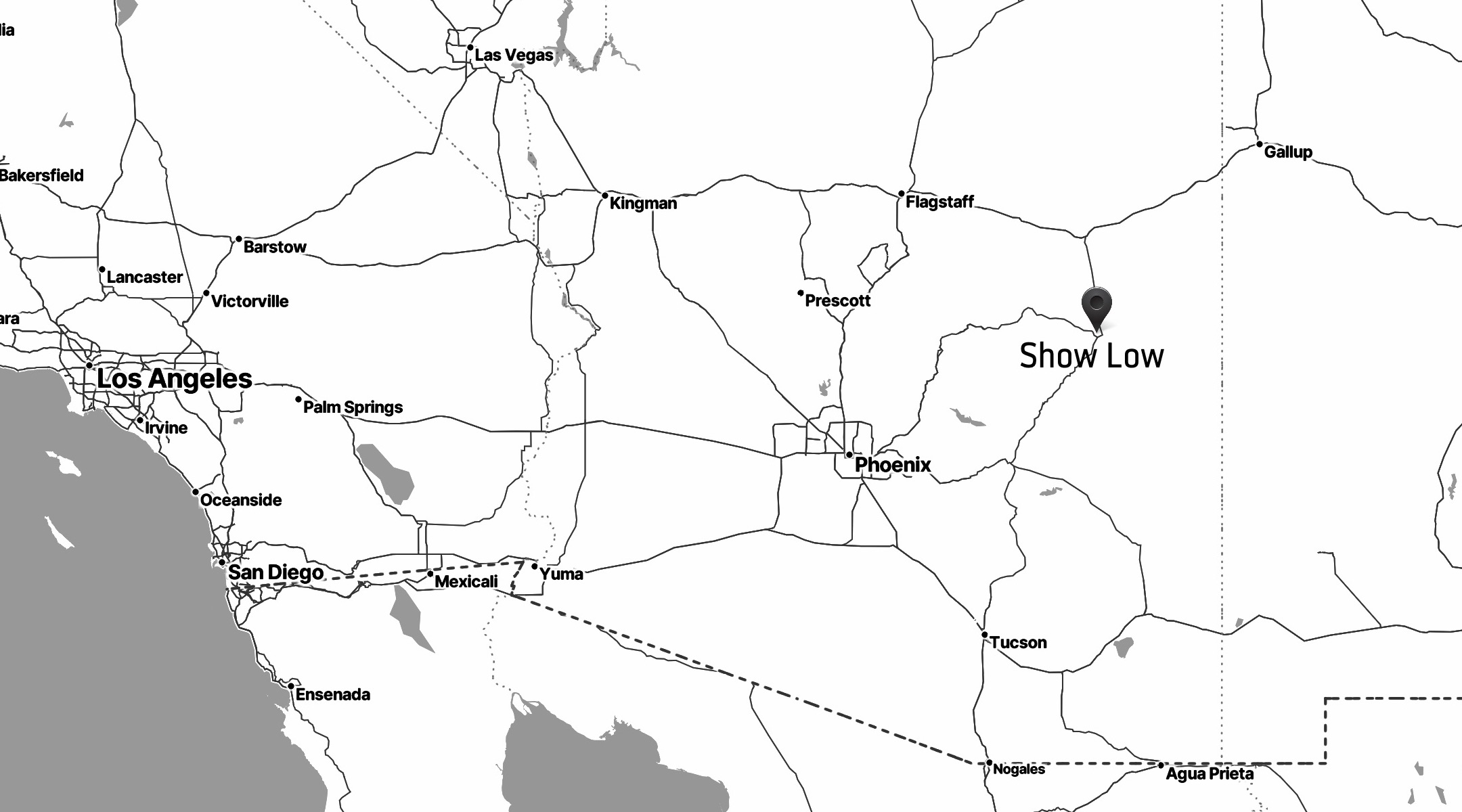
A map showing the location of Show Low, Arizona.
Cortes reached out to Singer and they began studying together, dismantling lessons internalized over the years. Singer had supported many people making a similar transition but this situation stood out to him. For a leader of a congregation to make such a drastic change knowing how it would shake his followers requires “extraordinary heroism,” Singer said.
“Richard was a huge leader in the Messianic movement and he saw through it, that they’re masquerading as a Jewish sect and peddling in theological misdirection,” Singer said.
To Cortes it felt like he had been lied to twice, first by traditional Christianity, and now by Messianism.
“We came out of the church with a big disappointment,” he said. “Hatred for the Jewish people that is really encoded in all the church’s teachings. You come into Messianic Judaism and you’re like, ‘Oh, wow, this is amazing. More than likely, this is how Yeshua prayed. He prayed like a Jew.’ But then, you say, ‘Wait a minute. There’s still an element that’s the foundation of Christianity.’”

Cortes was terrified to tell Alpha of his change of heart because of how challenging it had been to drag her to Messianism. He put off the conversation for as long as he could.
He asked to talk and began by telling her about how he’d been studying.
“I really think we are on the wrong path,” he said.
She asked him to explain. He gathered his courage and continued.
He told her they had been right to follow the Torah but that they had “missed the mark on the messiah.”
She gave him a puzzled look. “It’s about time,” she said.
He was confused. What’s about time?
She revealed that she had been having the same kind of internal conversion with herself and was waiting for him to catch up. Both of them were deeply relieved at the meeting of their souls.
“I was waiting for him for two years,” Alpha later said.
“My wife and I have always been best friends but this has unified us in such an amazing new way,” Richard said.
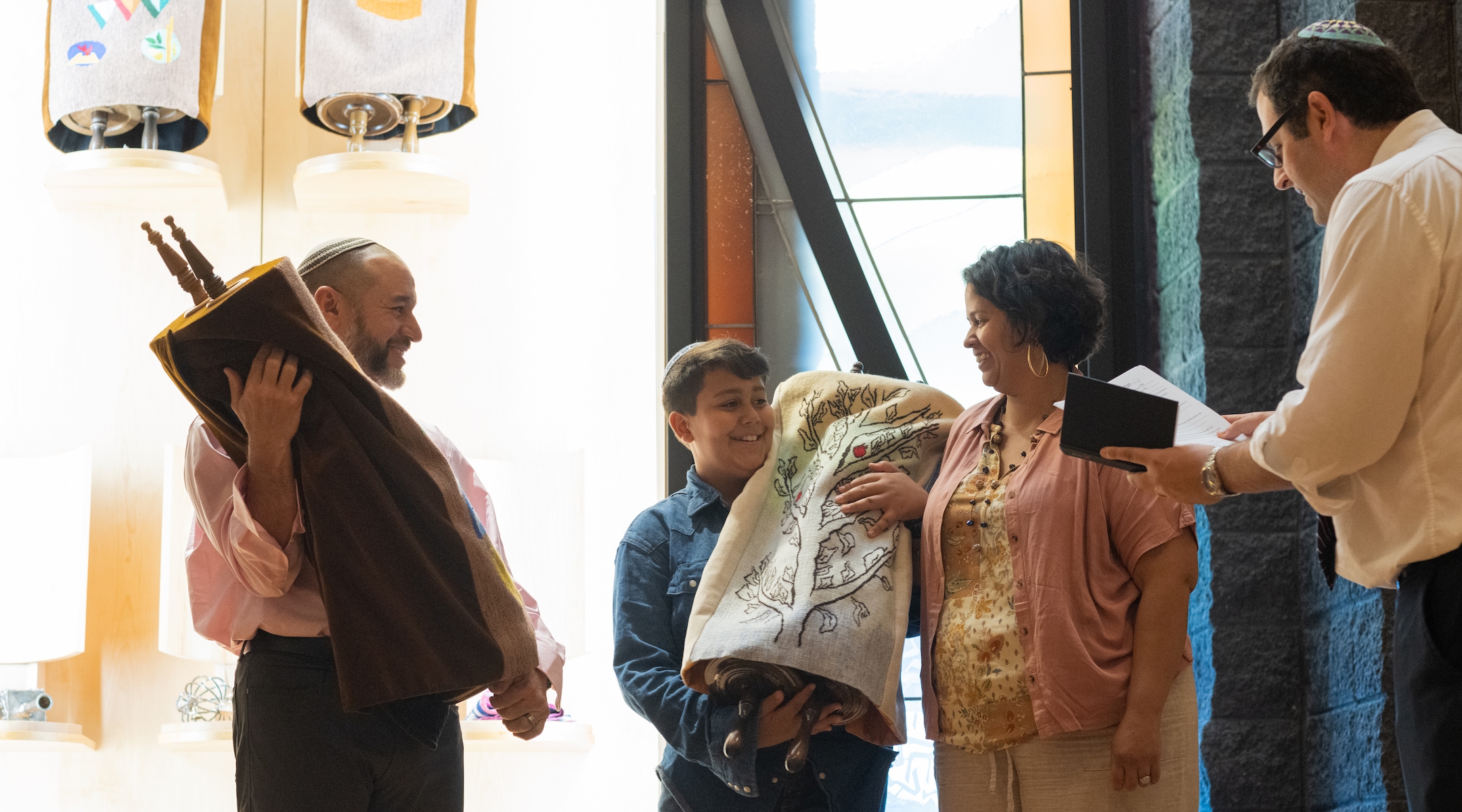
Richard and Alpha Cortes, and their son Israel, 11, are prayed over by Or Tzion rabbi Andy Green after their Mikveh at Congregation Beth Israel in Paradise Valley, Arizona, Aug. 17, 2023. (Caitlin O’Hara)
They didn’t yet know quite where they would land religiously once they exited the Messianic movement. From Show Low, with the nearest Jewish presence hours away, Judaism seemed out of reach, but Noahidism was appealing.
They knew they needed to tell the congregation about their transformation and they knew they needed to do so carefully. The emotional turmoil that Cortes unleashed, however, went far beyond his expectations. With his Facebook announcement last December, most of his congregants immediately fell away.
Many of their former friends and followers accused Richard of heresy and betrayal. “How could you turn your back to Jesus?” they asked in agony, Cortes recalled. They said he defrauded the community for having fundraised for a new building under allegedly false pretenses. When word reached the wider Messianic movement, community leaders put out what Cortes calls an “APB,” an alert that he was an apostate to Messianic Judaism.
“And that word went out to all the Messianic synagogues in the United States,” he said. “How I know this is I started getting phone calls from people that I didn’t even know that were asking me, ‘How can you forsake Jesus?’”
Cortes said that in the reaction to his announcement, including a former congregant calling him a “Christ killer,” he recognized a certain strand of hatred in the Messianic movement he hadn’t allowed himself to see before: antisemitism.
While dozens abandoned him, a core group remained, eager to take their Torah journey with Cortes where it would lead. The congregants that would join him on conversion day included Alpha; their 11-year-old son Israel; Richard’s mother, Nellie Vienna; and a longtime family friend named Evelyn Lopez, as well as two other families, the Birds and the Mosts.
The Birds had moved to Show Low from Alaska a few years earlier and quickly discovered the Foundation of the Word. Peter Bird supports his wife Audrey and five children by working as an urban and wildland firefighter. Audrey homeschools the kids. The Most family left Utah and moved to Show Low specifically to join Cortes’ congregation. David Most and his son Joel build custom log homes, and are married to Linda and Stefani, respectively. The Most family includes five children, who were born to Joel’s late former wife, Danielle, and who are also homeschooled.
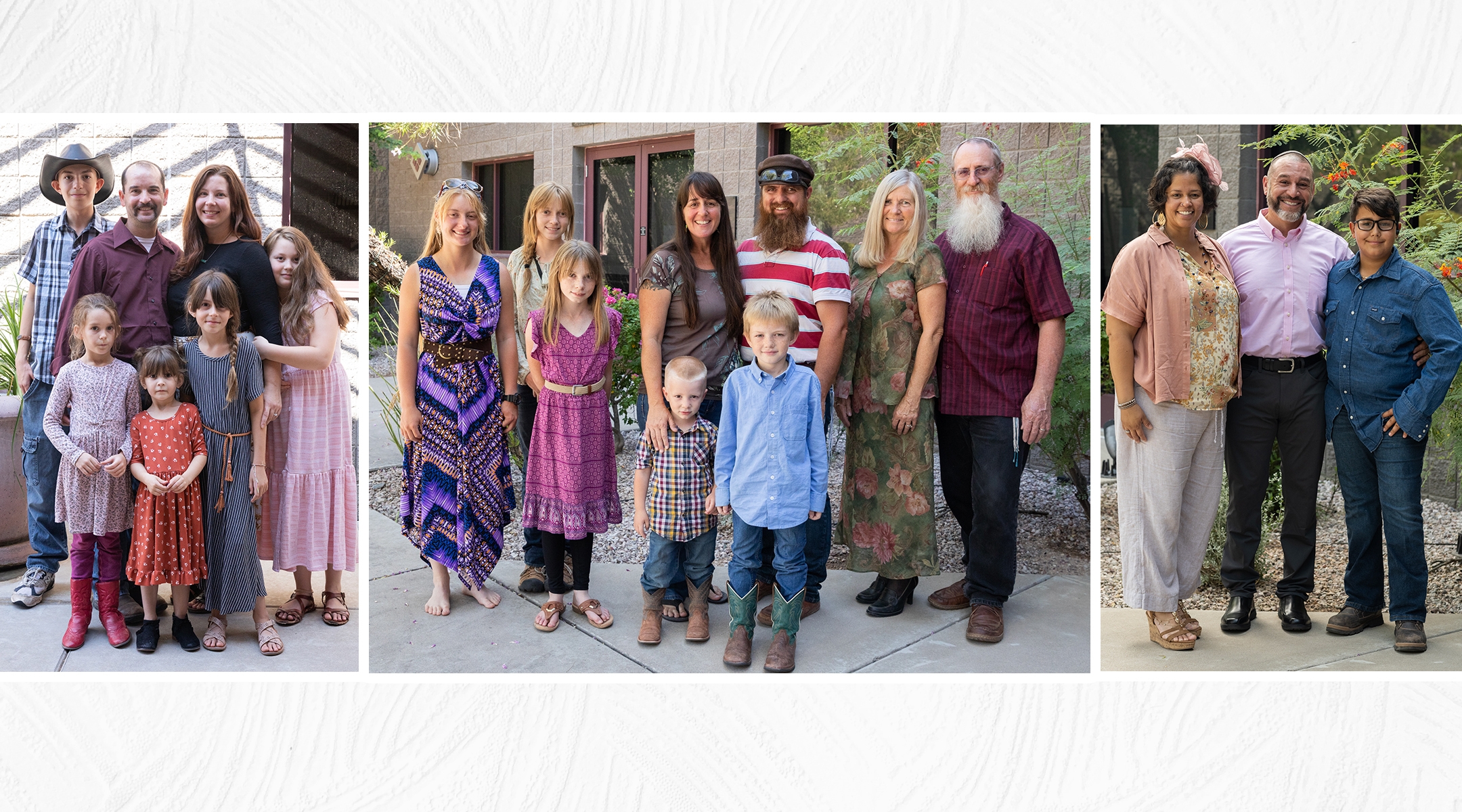
Left to right, the Bird, Most and Cortes families in Paradise Valley, Arizona, Aug. 17, 2023. (Caitlin O’Hara)
As a group, they enrolled in an 18-week online class through the Miller Introduction to Judaism Program at American Jewish University. Until recently, anyone interested in taking the course, typically a prerequisite for conversion, would have had to do so at the university’s Los Angeles campus or through one of the program’s synagogue partners. But during the pandemic, the program went online.
The Show Low contingent also began reaching out to rabbis online and in the Phoenix area, the closest major Jewish community. Singer would eventually visit the community for a daylong workshop in which he fielded questions and explained how Messianic claims about Jesus’s place in Judaism were deceitful.
Taylor, of the American Faith Coalition, would also pay them a visit and would be deeply impressed with Cortes. “Think of the amount of bravery and sincerity it takes to, as a community leader, admit you are going down a new line, which not only affects you and your family and their decisions, but your entire community,” Taylor said.
Not everyone was as willing to hear the Show Low group out. Orthodox Jews in Phoenix were especially reluctant to accept Cortes’ story, he said, because they had only recently fallen victim to a pair of undercover Christian missionaries who posed as rabbis and performed sacred rites. Cortes said he understood the suspicion: “I might be a threat, I might be a missionary.”

Eventually, Cortes found Rabbi Andy Green, who had taken up the pulpit at Congregation Or Tzion in Scottsdale in 2021. In Green, Cortes found the perfect person to welcome into Judaism a group of people with Messianic backgrounds. The rabbi had had a lifetime of experiences that would prepare him for this moment.
Already as a teenager, Green heard Singer, the counter-missionary rabbi, speak at his Jewish high school in Los Angeles. He also encountered Bentzion Kravitz, a rabbi working against the conversion of Jews to other religions, and in college Green became a volunteer for Kravitz’s group, Jews for Judaism.
“Rabbi Kravitz taught how to be proudly Jewish and not afraid to engage people with a distorted idea of Judaism,” Green said. “I had quality training in being able to understand missionaries and being able to be proud and articulate about my Jewishness even when challenged by missionaries.”
Green even developed a certain empathy for Messianics, as long as they were not proselytizing to Jews. He gave the example of a person from his college’s Hillel Jewish center whom he knew for years before learning of his Messianic belief.
“He was very secretive about his own background because he knew that if he outed himself as believing in Jesus as messiah he would be kind of uninvited and alienated from the Hillel Jewish space. But he never did anything that made us uncomfortable,” Green said. Today, the classmate is a clergy member in the Messianic movement.
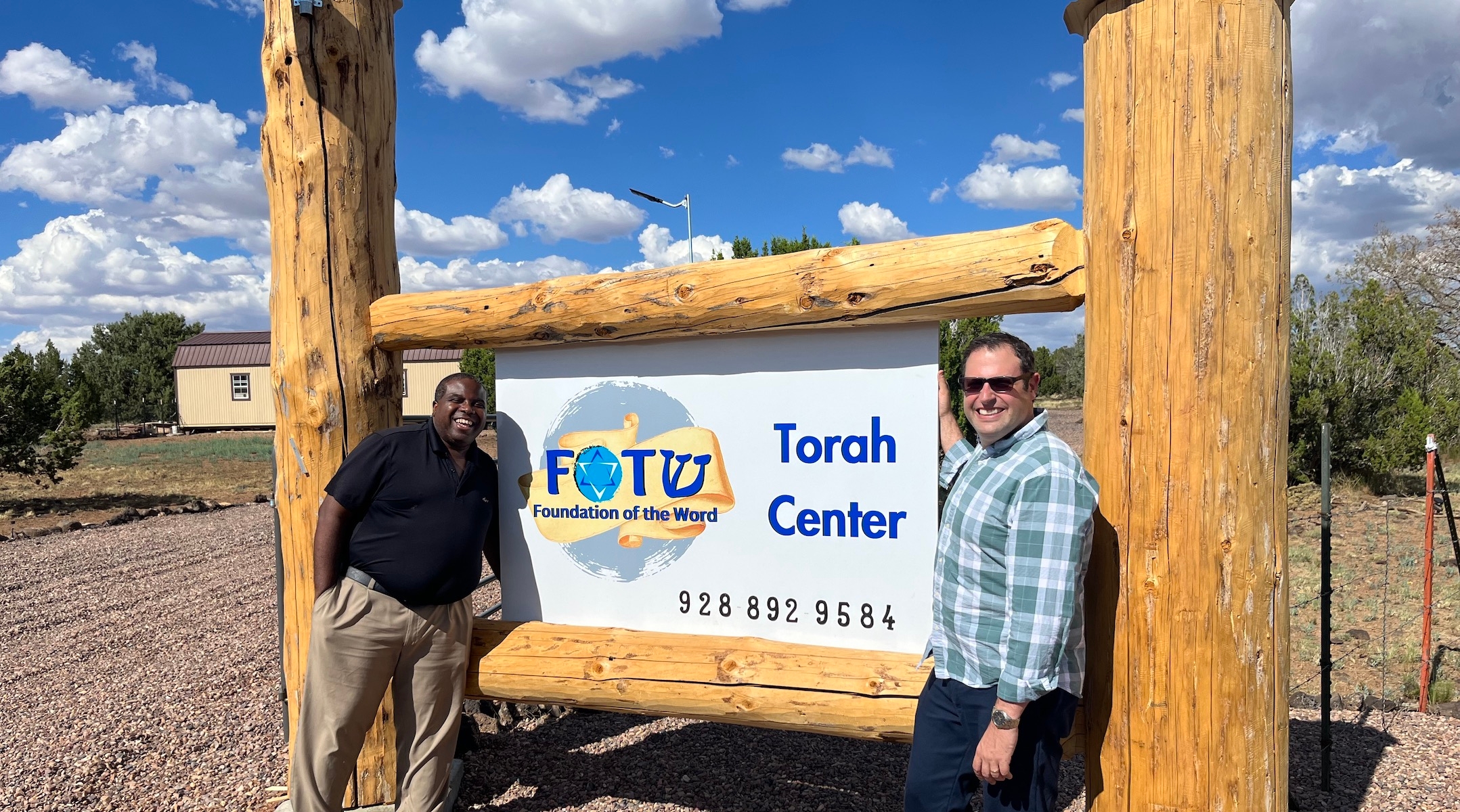
Rabbi Andy Green, right, and Andre Ivory, Or Tzion’s educational director, during a recent visit to Foundation of the Word in Show Low, Arizona. (Courtesy of Andy Green)
Green’s first experience with how a welcoming attitude can create a congregant out of a Messianic came a few years ago, before he joined Congregation Or Tzion, while he was serving as an assistant rabbi in the Philadelphia area. A member of a nearby Messianic center began attending events at his synagogue. Some communities might have asked the visitor to leave, but Green’s congregation did not — and she ended up converting to Judaism.
When members of the Show Low group started reaching out, Green knew how to relate to them. Rather than put up defenses, he listened and was stirred by their humility and sincerity.
“When someone comes from that kind of background, that can be an alarming and dangerous thing in the American Jewish psyche,” he said. “But I was less threatened perhaps than a colleague who had never had encounters or experiences with this in the past.”
Cortes and others from Show Low began talking to Green on the phone and via email, sharing their spiritual journeys and asking questions about Judaism and the conversion process. They also began attending Or Tzion’s online Shabbat services weekly on Zoom and made spirited contributions in the chat box. Appreciating their energy, Green gave them shoutouts and began telling his congregants about the Show Low group. The Cortes and Most families each paid a visit to Or Tzion for Shabbat, spending a weekend with the congregation.
In Show Low, Cortes and his community began making changes. Dropping “Outreach Ministries” from its name, Cortes redefined Foundation of the Word as a Jewish learning center. And they would eventually donate to Congregation Or Tzion, becoming members once they were Jewish.

Before the conversions could begin, the men and boys had to arrive a day early for a special ceremony. They were brought into a private room at Green’s synagogue where a congregant who is a physician was waiting. One by one, he drew a drop of blood from their penises in a ritual, known as hatafat dam brit, that symbolizes the covenant of circumcision for converts who are already circumcised. A stained gauze and the doctor’s testimony were submitted as proof to the conversion court, formed by Green, with his synagogue’s cantor, Dannah Rubinstein, and education director, Andre Ivory.
The next day started at 7:30 a.m. with a prayer service, which took place a short drive away from Or Tzion, at Congregation Beth Israel, a Reform synagogue that houses the only non-Orthodox mikvah, or ritual bath, in the area.
No one could recall a day with more conversions in a single mikvah, not in Phoenix and maybe not anywhere in the United States.
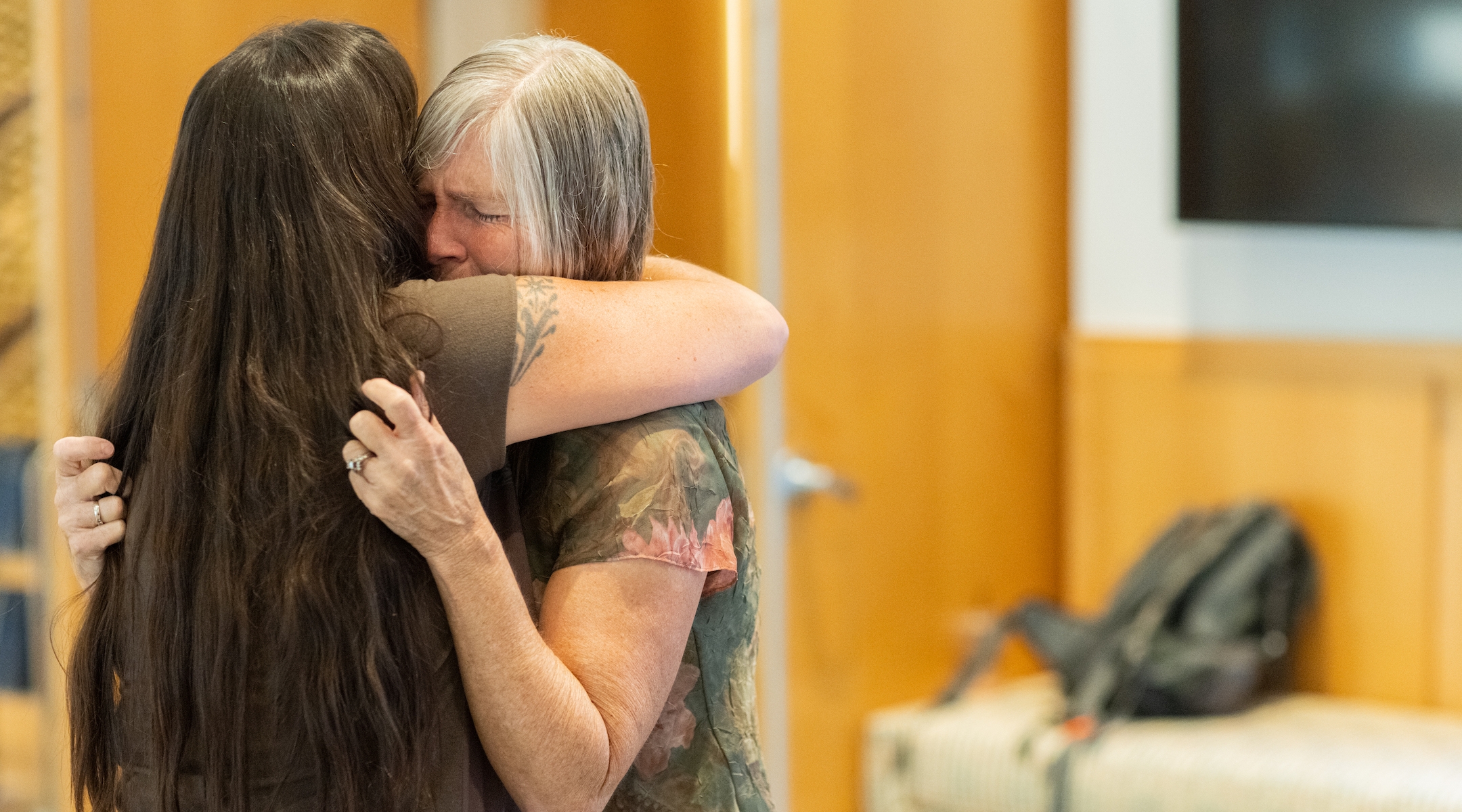
Linda Most hugs her daughter-in-law Stefani Most after her Mikveh at Congregation Beth Israel in Paradise Valley, Arizona, Aug. 17, 2023. (Caitlin O’Hara)
Throughout history, few groups of any kind have converted en masse to Judaism. Some evidence exists for a surge in converts in classical antiquity, but later, with the rise of Christianity and Islam, Jewish proselytizing was largely prohibited for centuries. In the early 2000s, rabbis formally converted hundreds of members of the Abayudaya community in Uganda, but the Abayudaya had already regarded themselves as Jewish for generations. In recent memory, the typical convert has been a single individual marrying into an established Jewish family.
It was the first day of the month of Elul on the Hebrew calendar, marking the birth of a new moon, and, Green noted, a propitious occasion for new beginnings. As the service went on, he invited two of his congregants to join him on the bimah, or synagogue stage, as he read from a Torah scroll.
“This is the last service where it isn’t your privilege quite yet and that’s exciting,” Green explained to the 21 men, women and children awaiting conversion.
Now came time for the prospective converts to appear before the conversion court and answer a series of questions about their intention and commitment. Only then, if the court was satisfied, would they be permitted to immerse in a ritual bath of living waters and emerge as Jews.
“I have confidence that we would not have reached this moment and that you would not be here if you weren’t going to pass that test. So don’t be scared. It’s not meant to be frightening,” Green said.
His words did little to dispel their sense of anticipation on a day that many described as among the most joyous and important in their lives.
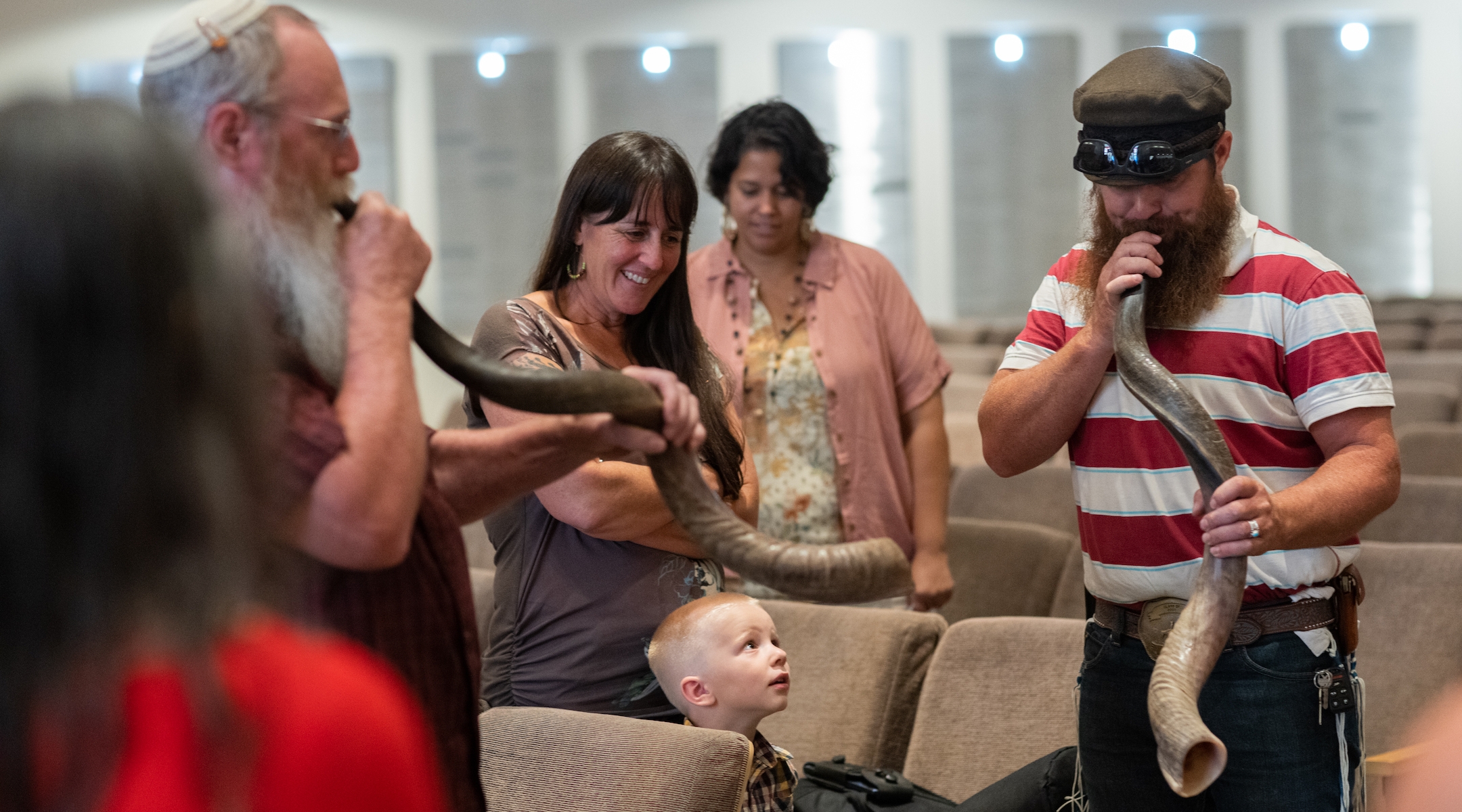
David Most and Joel Most play shofars at Congregation Beth Israel in Paradise Valley, Arizona, Aug. 17, 2023. (Caitlin O’Hara)
For Audrey Bird, the excitement had kept her from sleeping very deeply the night before. The ding of a phone notification that she was usually able to ignore woke her up. Any desire to fall back asleep faded away as soon as she saw it was the result of the DNA test she had taken a few weeks earlier.
A former Seventh-Day Adventist, Bird sensed she might have Jewish ancestry, and the timing of getting the result, just hours before she was set to undergo conversion, seemed almost too improbable to be a coincidence. The mystery of her background, which was impossible to unravel using her family’s few genealogical records, was about to end.
She clicked through and learned that her DNA was 11% Ashkenazi. Elated, she woke up her husband, Peter, and shoved the screen in his face.
“I felt such a strong pull towards Judaism that there had to be Judaism in our background. It’s not a huge percentage, but it shows that somewhere down the line of my family someone stood at the foot of Mount Sinai,” she said, referring to the location of God’s revelation to the Israelites in the Bible.
For Alpha Cortes, who donned a festive pink hat for the occasion, the joy of the day was mixed with a reckoning about a profound change to her relationship with her Catholic mother and siblings. Although her path had taken her from Catholicism, she had always shared a belief in Jesus with them.
“Religion is what has bound my family together so this day feels like entering an abyss,” Cortes said. “I’m mourning the abyss, but not because I have left their religion, because this decision is actually making me very happy. I know I am choosing the truth.”
She was tearing up as she spoke, but where the makeup she normally wore on special occasions would have smeared, her face was bare: Green instructed everyone that no cosmetics, or fabric or jewelry, come between their body and the living waters of the mikvah.
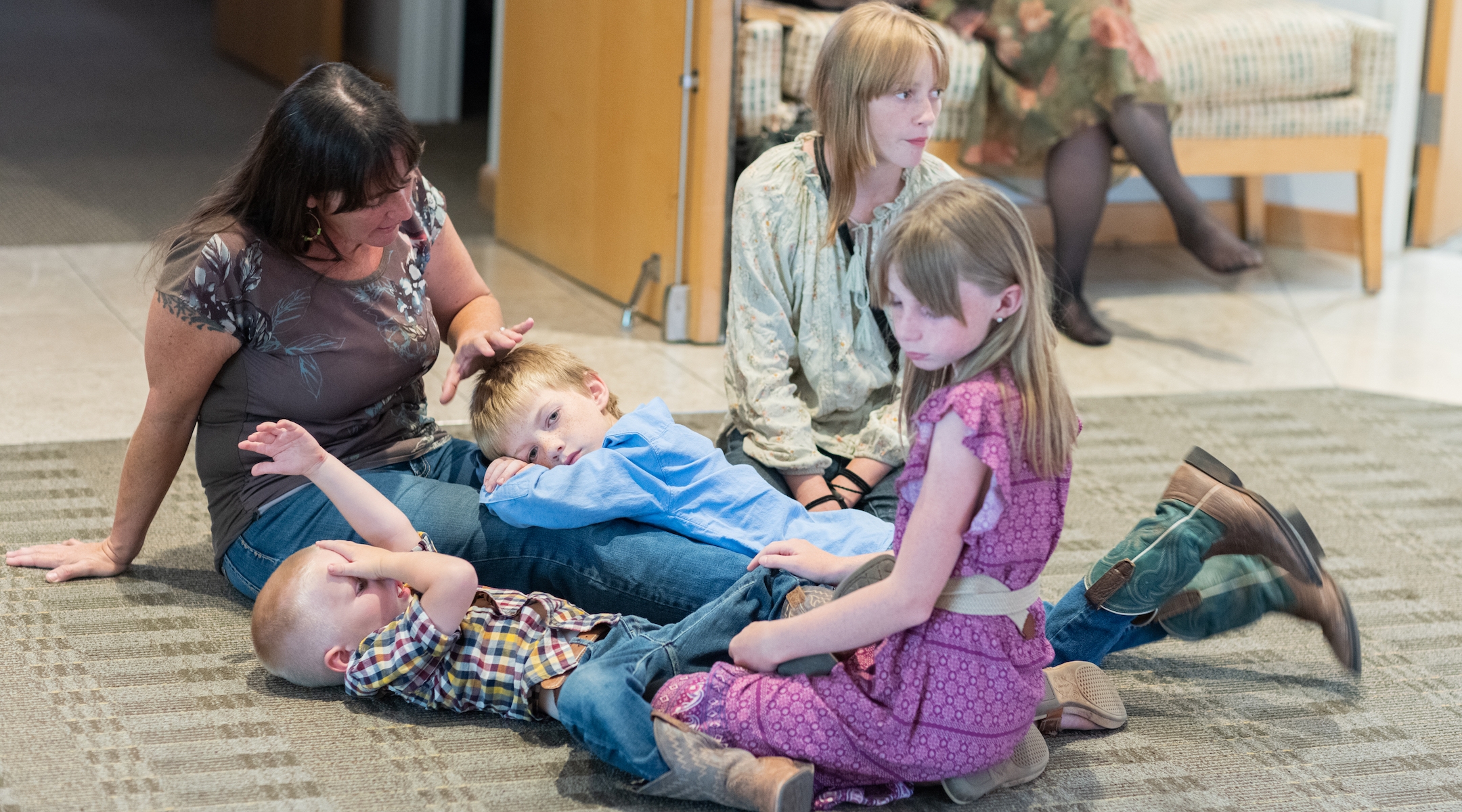
Stefani Most with her sons, Jubal, 3, and Joel Israel, 7, center, and daughters Merily, 13, and Fiona, 10, as they await their turn in the mikveh at Congregation Beth Israelin Paradise Valley, Arizona, Aug. 17, 2023. (Caitlin O’Hara)
Each member of the Show Low group went through the traditional steps of a conversion: an interview with a court of Jewish law, a complete immersion in the ritual bath, blessings and the bestowal of a Hebrew name. Alpha became Malka Rena; Richard, Akiva.
Then, at a ceremony marking the end of the day, the group added their own flourish to the procession of rituals. Father and son David and Joel Most, sporting long bushy beards, took out the shofars they brought from Show Low on Green’s invitation and lifted them to their lips.
It was their first time blowing the ram’s horn as Jews, but from the quality of the four piercing blasts, which lasted nearly a minute, it was clear the instrument was not new to them.
The shofar is popular among Messianic groups precisely because it’s seen as a potent and authentic Jewish symbol, David Most said. But looking back, he regretted how his relationship with the shofar had developed.
“One of the things that we didn’t know when we were in the Messianic Judaism was that you’re not supposed to play the shofar on Shabbat — and we would open the services with it,” he said.

The conversion of the Show Low group and the unique perspective they bring to Jewish practice is both a cause for celebration and a corrective to narratives of decline that have taken hold in the Jewish community, according to Jeffrey Herbst, president of American Jewish University.
Herbst has been drumming up attention for a concept he refers to as the influx of “distant relatives.” Whether it’s groups like the one in Show Low, individuals who become curious about Jewishness after receiving the results of an ancestry test or people from the former Soviet Union who realize they have significant Jewish heritage that had been suppressed under communism, there are perhaps millions of people with a newfound affinity to Judaism, he said.
In that spirit, last year, AJU’s Miller Intro to Judaism Program started making its online course available in Spanish.
“For the first time since the Second Temple, people are coming to us,” Herbst said. “The Jewish narrative is in part about a beleaguered demography. We’re so small and maybe in some ways we’re shrinking. And I don’t want to trivialize those concerns. But this is another perspective: There are people who want to either join us formally or be related or be supporters and we should embrace that.”
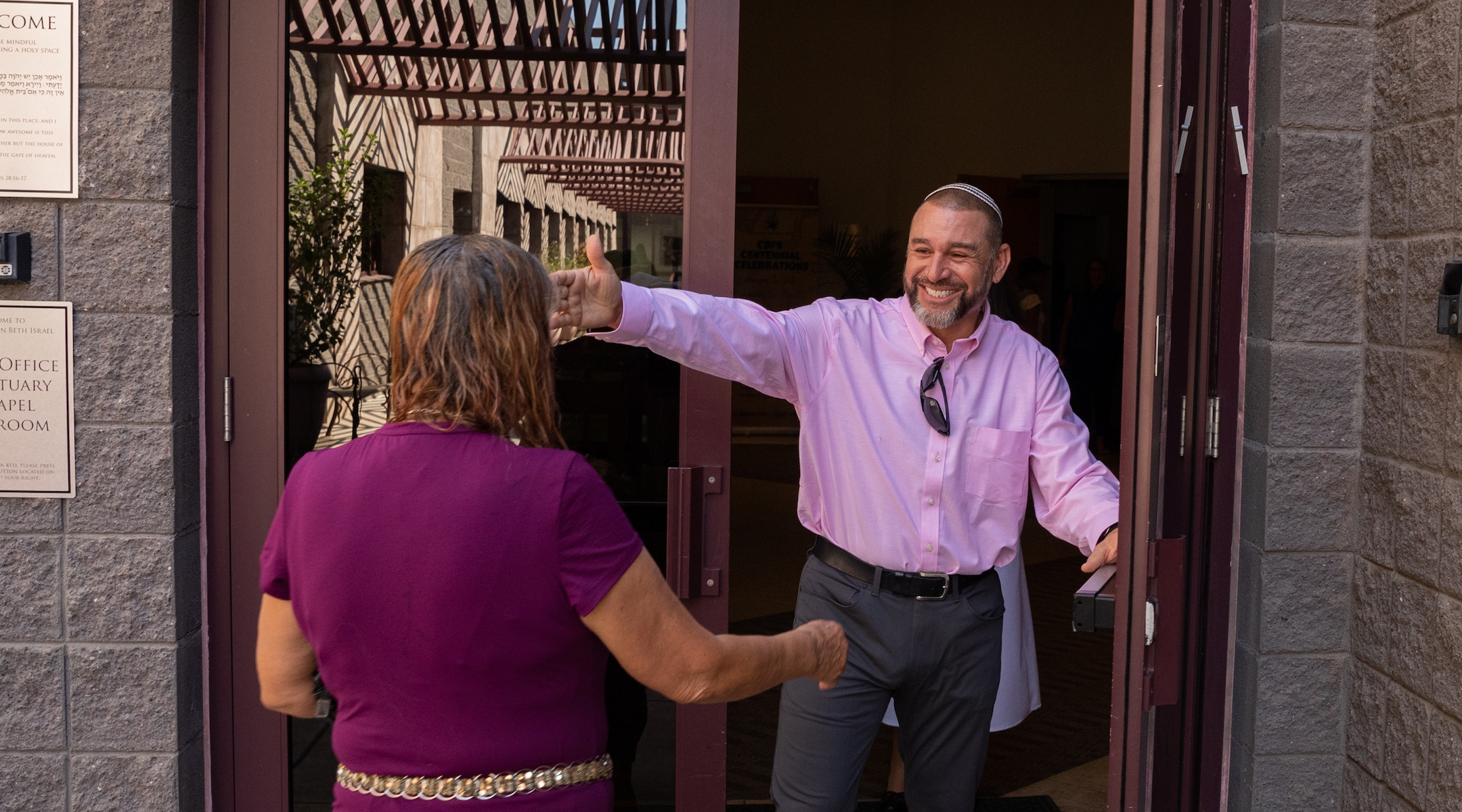
Nellie Viana, who was first to be submerged in the Mikveh celebrates by hugging her son Richard Cortes at Congregation Beth Israel in Paradise Valley, Arizona, Aug. 17, 2023. (Caitlin O’Hara)
For whatever changes this trend may bring to Jewishness, Herbst suggests getting over potential discomfort.
“There’s always been more diversity, perhaps, than we’ve accounted for,” he said. “Within the realm of people who are deeply committed, if they bring in somewhat different traditions, I think we should celebrate it.”
Much of the content at Foundation of the Word would be familiar to the average American Jewish synagogue member. The Show Low group studies classic Jewish texts and discusses the weekly Torah portion. They also read prayers from the Conservative prayer book provided by Green and continue to livestream the services he leads. His sermons call to mind the preacher he once was, but also the cadence of Orthodox rabbis who upload their lessons to YouTube.
“They’re adapting a kind of worship that’s more familiar to what they were doing before, but directing it toward the God of Israel and authentic Jewish learning,” Green said. “So instead of starting with the Christian rock songs that I’ve seen when I visited mega-churches, they’re singing Jewish pop and rock songs by artists like Benny Friedman and Mordechai Shapiro, and Nissim Black.”
For Cortes, who is an experienced religious leader but new to Judaism, the current moment is a bit daunting.
“We’re under a different order now. We are no longer pretending to be Jews. Now that we are part of the house, part of the people, we’re trying to figure out where we fit in now that we are in Judaism,” he said. “We’re more cautious in how we do things. We want to line up with traditional Judaism.”
One adjustment is that, in accordance with halacha, they no longer write on Shabbat.
“That was probably the day that we wrote the most because you come and you try to take down good notes about everything that you’ve learned,” he said.
Cortes thought he and others would go back to be with Congregation Or Tzion for Rosh Hashanah, but he decided against doing so for the first holiday after their conversion.
They instead embarked on a full High Holidays program in Show Low, complete with honey cakes. For Sukkot, the plan is to pitch a big Moroccan canvas tent with a roof that allows starlight to shine through and spend the holiday together outdoors. Green and Or Tzion’s educational director, Andre Ivory, hope to visit for a day.
Cortes said there’s also a scheduled visit to the Holocaust museum in Tucson, which should provide one element of a standard education for American Jewish youth.
The plan for giving the children a Jewish education throughout the year is still being formulated, but the parents have already begun integrating materials provided by Ivory into their homeschooling curriculum.

One source in the Talmud outlines the Jewish infrastructure that must be established before a community is suitable for a Torah scholar to take up residence: a synagogue, a mikvah, a charity fund, a school, a kosher butcher and more. Show Low has none of that. But their creation seems a lot less implausible today than it might have before.
Show Low is a small but growing community with a hospital, a regional airport and the most robust water resources in a parched state. Locals hope that with an influx of visitors coming for summer and winter outdoor recreation, the town can become another Flagstaff. People from Phoenix decamp for Show Low when it’s too hot, swelling the town’s summertime population. Show Low has also captured some of the remote work crowd and is poised for more.
It’s still remote enough that the Hasidic outreach group Chabad, known for its outposts serving Jews living in or traveling to in far-flung locations, has no local presence. But a small group from Chabad did visit the area a few weeks ago to meet local Jews. They arrived as part of Roving Rabbis, a program for young Chabad rabbis and rabbinical students during summer breaks and Jewish holidays. Their visit to the Show Low area happened before the conversion of Cortes’ group, and it’s unclear whether they would make a stop at Foundation of the Word in the future. As an Orthodox movement, Chabad has a complicated relationship with conversions by Conservative and other non-Orthodox rabbis.
For his part, Cortes says that while he continues to regard Green as a teacher and a leader, he has not committed to an exclusive relationship with Conservative Judaism. He’s already scheduled an introduction with Pinchas Allouche, the rabbi of an Orthodox synagogue in Scottsdale.
Meanwhile, a small group of Jews living in the area showed up at the Foundation of the Word for Shabbat dinner recently after learning about their conversion to Judaism. Afterward, one of them, Jan Perry, wrote about the experience on a Facebook page for local Jews with 30 followers, gushing with praise about the community, service, and food.
Cortes, whose title within his community is now “moreh” or teacher, was elated by the visit.
“It turns out, there are a lot more Jewish people here on the mountain,” he said. “Jan is on a mission to let all of them know about us.”
This article originally appeared on JTA.org.
















